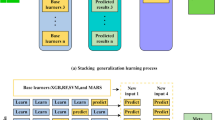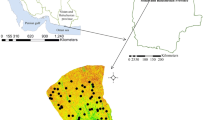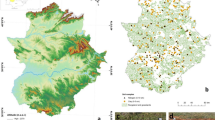Abstract
Data-driven stability prediction of slopes on the basis of survey data plays a vital role in geohazard prevention. A critical issue in data-driven stability prediction is that many factors can affect slope stability and have varied influences. Exploring the influence of different factors on the prediction model is helpful to improve its accuracy. In this paper, we used machine learning methods to predict soil slope stability based on soil slope survey data from four cities in Hunan Province, and evaluated the effects of groundwater and lithology on soil slope stability prediction. First, we analyzed and selected features using machine learning methods, i.e., random forest combined with SHapley Additive exPlanation (SHAP) values. Second, we constructed four machine learning models and compared the performance of the models. Finally, the best machine learning model was selected, and the influence of groundwater and lithology on the prediction of soil slope stability in the study area was explored using the SHAP method. The results show that the prediction accuracy and recall rate of the model decrease when only lithology is considered, while the prediction accuracy cannot be improved when only groundwater is considered. However, when combined with lithology, the prediction performance can be improved, and the accuracy and recall rate of the model are both improved by 0.01, and F-measure is improved by 0.02. The results of this paper can help improve the prediction accuracy of soil slopes in geohazard prevention.














Similar content being viewed by others
Data Availability
Data will be made available on request.
References
Anitescu C, Atroshchenko E, Alajlan N, Rabczuk T (2019) Artificial neural network methods for the solution of second order boundary value problems. Comput Mater Contin 59(1):345–359. https://doi.org/10.32604/cmc.2019.06641
Chen W, Peng J, Hong H, Shahabi H, Pradhan B, Liu J, Zhu AX, Pei X, Duan Z (2018) Landslide susceptibility modelling using GIS-based machine learning techniques for Chongren County, Jiangxi Province, China. Sci Total Environ 626:1121–1135. https://doi.org/10.1016/j.scitotenv.2018.01.124
Dai F, Lee C, Ngai Y (2002) Landslide risk assessment and management: An overview. Eng Geol 64:65–87. https://doi.org/10.1016/S0013-7952(01)00093-X
Dehn M, Bürger G, Buma J, Gasparetto P (2000) Impact of climate change on slope stability using expanded downscaling. Eng Geol 55(3):193–204. https://doi.org/10.1016/S0013-7952(99)00123-4
Fattahi H (2015) Prediction of slope stability state for circular failure a hybrid support vector machine with harmony search algorithm. Iran University of Science and Technology 5:103–115
Friedman JH (2001) Greedy function approximation: a gradient boosting machine. Ann Stat 29:1189–1232. https://doi.org/10.1214/aos/1013203451
Gitirana Jr G, Santos MA, Fredlund MD (2008) Three-dimensional slope stability model using finite element stress analysis.Geotech Spec Publ (178):191–198. https://doi.org/10.1061/40971(310)24
Han S, Wang H, Su S, Shi Y, Miao F (2022) Stable and efficient shapley value-based reward reallocation for multi-agent reinforcement learning of autonomous vehicles. International Conference on Robotics and Automation (ICRA) pp 8765–8771. https://doi.org/10.1109/ICRA46639.2022.9811626
Kardani N, Zhou A, Nazem M, Shen SL (2021) Improved prediction of slope stability using a hybrid stacking ensemble method based on finite element analysis and field data. J Rock Mech Geotech Eng 13:188–201. https://doi.org/10.1016/j.jrmge.2020.05.011
Lackner ON, Hartmann R, R (1997) Stability analysis of rock slopes with the direct sliding blocks method.Int J Rock Mech Min Sci 34:220.e1–220.e8. https://doi.org/10.1016/S1365-1609(97)00206-2
Li X, Kong JM, Wang CH (2010) Application of multi-classification support vector machine in the identification of landslide stability. Jilin Daxue Xuebao (Diqiu Kexue Ban)/Journal of Jilin University (Earth Science Edition) 40:631–637. https://doi.org/10.3969/j.issn.1671-5888.2010.03.021
Lin Y, Zhou K, Li J (2018) Prediction of slope stability using four supervised learning methods. IEEE Access 6:31169–31179. https://doi.org/10.1109/access.2018.2843787
Lundberg SM, Lee SI (2017) A unified approach to interpreting model predictions. Adv Neural Inf Process Syst pp 4766–4775. https://doi.org/10.48550/arXiv.1705.07874
Lundberg SM, Erion G, Chen H, DeGrave A, Prutkin JM, Nair B, Katz R, Himmelfarb J, Bansal N, Lee SI (2020) From local explanations to global understanding with explainable ai for trees. Nat Mach Intell 2(1):56–67. https://doi.org/10.1038/s42256-019-0138-9
Ma J, Tang H, Liu X, Hu X, Sun M, Song Y (2017) Establishment of a deformation forecasting model for a step-like landslide based on decision tree c5.0 and two-step cluster algorithms: a case study in the three gorges reservoir area, china. Landslides 14(3):1275–1281. https://doi.org/10.1007/s10346-017-0804-0
Ma Z, Mei G (2021) Deep learning for geological hazards analysis: Data, models, applications, and opportunities. Earth Sci Rev 223:1–33. https://doi.org/10.1016/j.earscirev.2021.103858
Ma Z, Mei G, Cuomo S (2021a) An analytic framework using deep learning for prediction of traffic accident injury severity based on contributing factors. Accid Anal Prev 160:1–16. https://doi.org/10.1016/j.aap.2021.106322
Ma Z, Mei G, Prezioso E, Zhang Z, Xu N (2021b) A deep learning approach using graph convolutional networks for slope deformation prediction based on time-series displacement data. Neural Comput & Applic 33(21):14441–14457. https://doi.org/10.1007/s00521-021-06084-6
Mahmoodzadeh A, Mohammadi M, Hama Ali H, Ibrahim H, Abdulhamid S, Nejati H (2022) Prediction of safety factors for slope stability: comparison of machine learning techniques. Nat Hazards 111. https://doi.org/10.1007/s11069-021-05115-8
Marjanovic M, Bajat B, Kovacevic M (2009) Landslide susceptibility assessment with machine learning algorithms. In: International conference on intelligent networking and collaborative systems pp 273–278. https://doi.org/10.1109/INCOS.2009.25
Moayedi H, Hayati S (2018) Modelling and optimization of ultimate bearing capacity of strip footing near a slope by soft computing methods. Appl Soft Comput 66:208–219. https://doi.org/10.1016/j.asoc.2018.02.027
Mojtahedi SFF, Tabatabaee S, Ghoroqi M, Soltani Tehrani M, Gordan B, Ghoroqi M (2018) A novel probabilistic simulation approach for forecasting the safety factor of slopes: a case study. Engineering with Computers 35(2):637–646. https://doi.org/10.1007/s00366-018-0623-5
Na KL, Liew M, Matori A, Wan Abdullah Zawawi NA (2017) Recent developments in machine learning applications in landslide susceptibility mapping. AIP Conference Proceedings 1905. https://doi.org/10.1063/1.5012210
Phoon KK, Zhang W (2022) Future of machine learning in geotechnics. Georisk: assessment and management of risk for engineered systems and geohazards pp 1–16. https://doi.org/10.1080/17499518.2022.2087884
Ping Y, Liu M, Zheng S (2004) Stability analysis of expansive soil slope with rainfall infiltration. Chin J Rock Mech Eng 23:4478–4484. https://doi.org/10.3321/j.issn:1000-6915.2004.z1.044
Qi C, Tang X (2018) Slope stability prediction using integrated metaheuristic and machine learning approaches: a comparative study. Comput Ind Eng 118:112–122. https://doi.org/10.1016/j.cie.2018.02.028
Shahriar SA, Kayes I, Hasan K, Hasan M, Islam R, Awang NR, Hamzah Z, Rak AE, Salam MA (2021) Potential of arima-ann, arima-svm, dt and catboost for atmospheric pm2.5 forecasting in Bangladesh. Atmosphere 12(1). https://doi.org/10.3390/atmos12010100
Sun G, Lin S, Zheng H, Tan Y, Sui T (2020) The virtual element method strength reduction technique for the stability analysis of stony soil slopes. Comput Geotech 119. https://doi.org/10.1016/j.compgeo.2019.103349
Svetnik V, Liaw A, Tong C, Culberson JC, Sheridan RP, Feuston BP (2003) Random forest a classification and regression tool for compound classification and qsar modeling.J Chem Inf Comput Sci 43:1947-1958. https://doi.org/10.1021/ci034160g
Tang SL, Han BB, Li ZB, Sun LH (2014) Analysis on instability of a high fill and deep excavation loess slope. Appl Mech Mater 675:187–190. https://doi.org/10.4028/www.scientific.net/AMM.675-677.187
Thiebes B, Bell R, Glade T, Jäger S, Mayer J, Anderson M, Holcombe L (2013) Integration of a limit-equilibrium model into a landslide early warning system. Landslides 11(5):859–875. https://doi.org/10.1007/s10346-013-0416-2
Wang HH, Wang JX, Wang KZ (2003) Plastic limit analysis of slope stability using finite element. Rock Soil Mech 24:733–738. https://doi.org/10.3969/j.issn.1000-7598.2003.05.013
Wang J, Wang H, Wu Y (2004) Stability analysis of soil slope by finite element method with plastic limit upper bound. Chin J Rock Mech Eng 23:1867–1873. https://doi.org/10.3321/j.issn:1000-6915.2004.11.016
Wang L, Wu C, Yang Z, Wang L (2023) Deep learning methods for time-dependent reliability analysis of reservoir slopes in spatially variable soils. Comput Geotech 159. https://doi.org/10.1016/j.compgeo.2023.105413
Wang M, Zheng K, Yang Y, Wang X (2020) An explainable machine learning framework for intrusion detection systems. IEEE Access 8:73127–73141. https://doi.org/10.1109/access.2020.2988359
Yang Y, Mei G, Izzo S (2022) Revealing influence of meteorological conditions on air quality prediction using explainable deep learning. IEEE Access 10:50755–50773. https://doi.org/10.1109/access.2022.3173734
Yang Z, Zhang D, Deng B, Chen W (2013) Application of optimization model based on neural network in softening slope stability by strong rainfall infiltration. In: Fourth international conference on intelligent control and information processing (ICICIP) pp 289–292. https://doi.org/10.1109/ICICIP.2013.6568084
Zhang W, Gu X, Tang L, Yin Y, Liu D, Zhang Y (2022) Application of machine learning, deep learning and optimization algorithms in geoengineering and geoscience: comprehensive review and future challenge. Gondwana Res 109:1–17. https://doi.org/10.1016/j.gr.2022.03.015
Zhang W, Li H, Han L, Chen L, Wang L (2022b) Slope stability prediction using ensemble learning techniques: a case study in Yunyang County, Chongqing, China. J Rock Mech Geotech Eng 14(4):1089–1099. https://doi.org/10.1016/j.jrmge.2021.12.011
Zheng H, Yuan J, Chen L (2017) Short-term load forecasting using emd-lstm neural networks with a xgboost algorithm for feature importance evaluation. Energies 10(8). https://doi.org/10.3390/en10081168
Zhou J, Li E, Yang S, Wang M, Shi X, Yao S, Mitri HS (2019) Slope stability prediction for circular mode failure using gradient boosting machine approach based on an updated database of case histories. Saf Sci 118:505–518. https://doi.org/10.1016/j.ssci.2019.05.046
Funding
This work was supported by the Natural Science Foundation of China (Grant Numbers 42277161 and 42207215) and the Fundamental Research Funds for the Central Universities (2652018091).
Author information
Authors and Affiliations
Corresponding author
Additional information
Publisher's Note
Springer Nature remains neutral with regard to jurisdictional claims in published maps and institutional affiliations.
Rights and permissions
Springer Nature or its licensor (e.g. a society or other partner) holds exclusive rights to this article under a publishing agreement with the author(s) or other rightsholder(s); author self-archiving of the accepted manuscript version of this article is solely governed by the terms of such publishing agreement and applicable law.
About this article
Cite this article
Gao, W., Zang, M. & Mei, G. Exploring influence of groundwater and lithology on data-driven stability prediction of soil slopes using explainable machine learning: a case study. Bull Eng Geol Environ 83, 2 (2024). https://doi.org/10.1007/s10064-023-03466-z
Received:
Accepted:
Published:
DOI: https://doi.org/10.1007/s10064-023-03466-z




